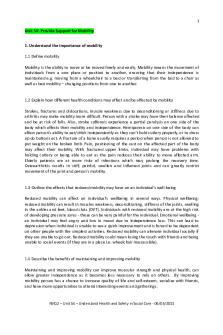Mobility and crutches PDF

| Title | Mobility and crutches |
|---|---|
| Course | Medical Surgical 2 |
| Institution | Loyola University Chicago |
| Pages | 1 |
| File Size | 212 KB |
| File Type | |
| Total Downloads | 93 |
| Total Views | 138 |
Summary
Download Mobility and crutches PDF
Description
STUDENT NAME SKILL NAME
Mobility/Immobility - Climbing stairs with crutches
REVIEW MODULE CHAPTER
Ch. 40
Description of Skill Crutches are assistive devices used to help patients ambulate and help with mobility when lower extremity is impaired. They are used to maintain or aid in regaining body ailment and stability, decrease musculoskeletal system changes, and achieve full or optimal ROM, and prevent contractures.
Indications Used for temporary or permanent condition where compromise of lower extremities and weight bearing exists with a patient. Fractured leg, foot. cast or boot. Sprained ankles Broken foot, ankle, leg Balance/Coordination Impairment Weakness of the lower extremities ROM Restriction Amputation
CONSIDERATIONS
Nursing Interventions (pre, intra, post) - PRE: Assess ROM capability, muscle tone, mass, monitor gait, and assess for additional assisted devices needed and assess patient for correct fit of crutches and adjust to patient’s height; approximately 2-3 finger widths between the axilla and the top of the crutch. Position hands on hand grips w/ elbows flexed at 30* (do not bear weight on axilla). The tripod position is the basic crutch stance. The patient should place the crutches 15 cm (6inches) in front of and 15 cm to the side of each food to provide wide base of support. Patient should stand with straight back, hips, head and neck and should not place any weight on axillae. Educate patient on proper use.
Outcomes/Evaluation Client Education Evaluate patient teaching by using teach back method. Evaluate patient response to activity and any adjustments that may be needed through oral feedback.
Potential Complications - Improper use can lead to nerve damage in the axillae region. - Irritation of the skin through rubbing and chaffing of the crutch saddle under the arm and axillae. - Long-term crutch use can result in wrist or hand injuring due to high stress over the upper portion of the hand.
ACTIVE LEARNING TEMPLATES
- Patient should place weight on the hand grips not the crutch rest pad while ambulating. This prevents nerve damage that can occur within the axillae region. - Begin your step as if you were going to use the injured foot or leg, but shift your weight to the crutches instead of the injured foot. Your body swings forward between the crutches. Finish the step normally with your noninjured leg. When the non-injured leg is on the ground, move your crutches ahead in preparation for the next step
Nursing Interventions - INTRA: Observe for correct use. Place the affected leg and the crutches down on the step below; support weight by leaning on the crutches and the stair rail. Bring the unaffected leg down. Remember the affected leg goes down first and the crutches move with the affected leg. Go up the stairs patient will move the good leg UP first onto the step and then move the bad leg(injured leg) and crutches up onto the step. - POST: Assess patients use of crutches and ability to use them for going up and down the stairs. Evaluate for potential barriers and improvements that need to be made.
THERAPEUTIC PROCEDURE A9...
Similar Free PDFs

Mobility and crutches
- 1 Pages

Mobility and immobility
- 19 Pages

Global Population and Mobility
- 4 Pages

Social Mobility
- 2 Pages

Mobility DOF PPT
- 17 Pages

Chapter 6 Social Mobility
- 4 Pages

Module 2 Safety and Mobility (5)
- 16 Pages

Hesi Case Study Mobility
- 4 Pages

Nursing Care Plan- mobility
- 2 Pages

Social Mobility - Lecture notes 28
- 31 Pages

Active Mobility Act 2017 Latest
- 135 Pages
Popular Institutions
- Tinajero National High School - Annex
- Politeknik Caltex Riau
- Yokohama City University
- SGT University
- University of Al-Qadisiyah
- Divine Word College of Vigan
- Techniek College Rotterdam
- Universidade de Santiago
- Universiti Teknologi MARA Cawangan Johor Kampus Pasir Gudang
- Poltekkes Kemenkes Yogyakarta
- Baguio City National High School
- Colegio san marcos
- preparatoria uno
- Centro de Bachillerato Tecnológico Industrial y de Servicios No. 107
- Dalian Maritime University
- Quang Trung Secondary School
- Colegio Tecnológico en Informática
- Corporación Regional de Educación Superior
- Grupo CEDVA
- Dar Al Uloom University
- Centro de Estudios Preuniversitarios de la Universidad Nacional de Ingeniería
- 上智大学
- Aakash International School, Nuna Majara
- San Felipe Neri Catholic School
- Kang Chiao International School - New Taipei City
- Misamis Occidental National High School
- Institución Educativa Escuela Normal Juan Ladrilleros
- Kolehiyo ng Pantukan
- Batanes State College
- Instituto Continental
- Sekolah Menengah Kejuruan Kesehatan Kaltara (Tarakan)
- Colegio de La Inmaculada Concepcion - Cebu




